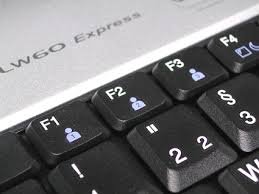They’re called “FUNCTION KEYS”. They’ve been around since before Windows and they are still useful in so many ways. Every piece of software might have different functions programmed behind these keys, but I’ve found many functions that are common amongst many programs. I’ve listed a few of favourite F-Keys:
F1 – HELP! This is the most useful key of the bunch. Pressing the F1 key in any windows program will bring up the Help File. This Help File contains all of the information that used to be included in paper manuals of the old days. It actually contains much more information than was ever available in paper format. Almost all of the help files also contain a search feature allowing you to zero in on the information you are looking for
F2 – Rename. This is useful for renaming files, changing your picture file from img_001.jpg to a more descriptive filename. Just select the file and press f2, then type the new filename you want.
F3 – Find / Search. Try it next time you are looking for a file in Windows. In Microsoft Word pressing SHIFT+F3 will cycle from no capitals to all capitals to capitals on the first letter of each word. Highlight the text you want to change the capitalization on and press SHIFT + F3 for all caps on each word, press
again for all caps and again to go back to lowercase letters.
F4 – ALT+ F4 will close the open program
F5 – Refreshes the page in Internet Explorer. Starts a slideshow in PowerPoint
F6 – Moves the cursor to the address bar in Internet Explorer, allowing you to quickly type in a new website address
F7 – SHIFT + F7 in Microsoft Word will bring up the Thesaurus. Highlight the word you are interested in and Press SHIFAT+F7 and you are presented with synonyms for that word. This is VERY useful for typing letters and reports.
F8 - Pressing F8 when booting up your computer will allow you to enter Safe Mode of Windows
F10 – Activates the Menu Bar for most Windows programs. SHIFT + F10 is the same as right-clicking on an icon or file.
F11 – Full Screen Layout For Internet Explorer Web Browser. The next time you are surfing the Internet just press the F11 key. The webpage you are viewing will now be shown on the entire screen; no task bar and even the menu bar will auto-hide itself after a few seconds. If you need to access the menu just move the mouse to the top of the screen and the Internet Explorer menus will come back. While in the full screen (F11) mode I find it useful to use the BACKSPACE key to go back one page. (Did you know that you could use the backspace key for this?)
F12 – Opens Save As in Microsoft Word. CTRL+SHIFT+F12 will print the document in Word.
F1 – HELP! This is the most useful key of the bunch. Pressing the F1 key in any windows program will bring up the Help File. This Help File contains all of the information that used to be included in paper manuals of the old days. It actually contains much more information than was ever available in paper format. Almost all of the help files also contain a search feature allowing you to zero in on the information you are looking for
F2 – Rename. This is useful for renaming files, changing your picture file from img_001.jpg to a more descriptive filename. Just select the file and press f2, then type the new filename you want.
F3 – Find / Search. Try it next time you are looking for a file in Windows. In Microsoft Word pressing SHIFT+F3 will cycle from no capitals to all capitals to capitals on the first letter of each word. Highlight the text you want to change the capitalization on and press SHIFT + F3 for all caps on each word, press
again for all caps and again to go back to lowercase letters.
F4 – ALT+ F4 will close the open program
F5 – Refreshes the page in Internet Explorer. Starts a slideshow in PowerPoint
F6 – Moves the cursor to the address bar in Internet Explorer, allowing you to quickly type in a new website address
F7 – SHIFT + F7 in Microsoft Word will bring up the Thesaurus. Highlight the word you are interested in and Press SHIFAT+F7 and you are presented with synonyms for that word. This is VERY useful for typing letters and reports.
F8 - Pressing F8 when booting up your computer will allow you to enter Safe Mode of Windows
F10 – Activates the Menu Bar for most Windows programs. SHIFT + F10 is the same as right-clicking on an icon or file.
F11 – Full Screen Layout For Internet Explorer Web Browser. The next time you are surfing the Internet just press the F11 key. The webpage you are viewing will now be shown on the entire screen; no task bar and even the menu bar will auto-hide itself after a few seconds. If you need to access the menu just move the mouse to the top of the screen and the Internet Explorer menus will come back. While in the full screen (F11) mode I find it useful to use the BACKSPACE key to go back one page. (Did you know that you could use the backspace key for this?)
F12 – Opens Save As in Microsoft Word. CTRL+SHIFT+F12 will print the document in Word.
Comments
Post a Comment